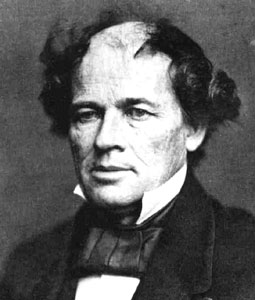
Matthew Fontaine Maury
Oceanographer and author Matthew F. Maury was born on January 14, 1806, in Fredericksburg, Virginia. His family moved to Williamson County, Tennessee, when he was five. Maury attended Harpeth Academy in Franklin and studied under Gideon Blackburn and James Otey, the first Episcopal Bishop of Tennessee. He joined the navy as a midshipman at age nineteen with his first posting on the USS Brandywine, the ship chosen to escort Lafayette home to France. While on board the Brandywine Maury met the future Admiral David Farragut.
In 1834 Maury married Ann Hull Herndon, and they lived in Fredericksburg, Virginia, for seven years. During this time, Maury published a number of books and articles, most notably A New Theoretical and Practical Treatise on Navigation (1836). The Treatise, better known as Maury’s Navigation, became the standard text for the Naval Academy at Annapolis.
In 1842 Maury was named superintendent of the Navy Depot of Charts and Instruments, later known as the Naval Observatory. He published papers on the Gulf Stream and ocean currents in 1844 and also authored the books A Scheme for Building Southern Commerce; Wind and Current Charts; and Sailing Directions. He called a general maritime conference in Brussels that standardized the logs kept by captains. In 1856 he published The Physical Geography of the Sea.
When Virginia seceded, Maury resigned from the U.S. Navy and entered the Confederate Navy in June 1861 with the rank of commander. He was sent to Europe to continue earlier experiments on torpedoes. Eventually, Maury invented a method of arranging and testing torpedo mines using an electrical detonation system. He was ready to put his system into operation when Robert E. Lee surrendered.
Maury returned to the United States and became a professor of physics at Virginia Military Institute, where he continued to write books on the sea and geography. Maury died on February 1, 1873, in Lexington, Virginia, and is buried in Richmond, Virginia.
Honored all over the world as the founder of a new science, Maury was the first man to describe the Gulf Stream and to mark sea routes across the Atlantic Ocean. He instituted the system of deep-sea sounding and suggested the laying of transoceanic telegraph cables, which later became a reality. His work earned him the nickname “Pathfinder of the Seas.”



